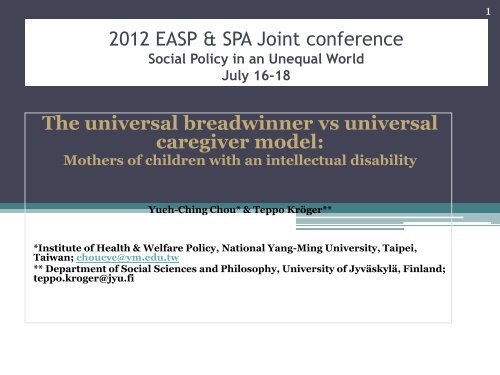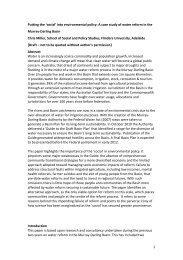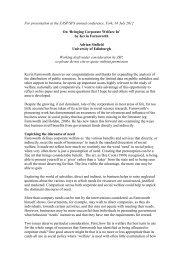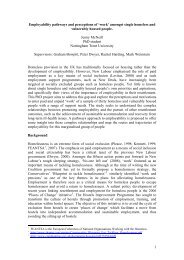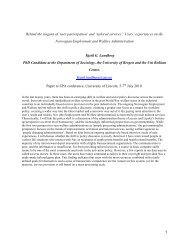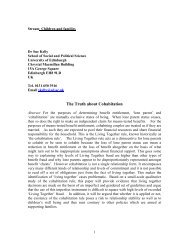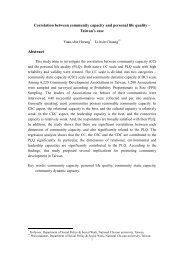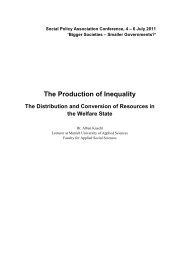Yueh-Ching Chou, Teppo Kröger The universal breadwinner model ...
Yueh-Ching Chou, Teppo Kröger The universal breadwinner model ...
Yueh-Ching Chou, Teppo Kröger The universal breadwinner model ...
Create successful ePaper yourself
Turn your PDF publications into a flip-book with our unique Google optimized e-Paper software.
2012 EASP & SPA Joint conference<br />
Social Policy in an Unequal World<br />
July 16-18<br />
1<br />
<strong>The</strong> <strong>universal</strong> <strong>breadwinner</strong> vs <strong>universal</strong><br />
caregiver <strong>model</strong>:<br />
Mothers of children with an intellectual disability<br />
<strong>Yueh</strong>-<strong>Ching</strong> <strong>Chou</strong>* & <strong>Teppo</strong> <strong>Kröger</strong>**<br />
*Institute of Health & Welfare Policy, National Yang-Ming University, Taipei,<br />
Taiwan; choucyc@ym.edu.tw<br />
** Department of Social Sciences and Philosophy, University of Jyväskylä, Finland;<br />
teppo.kroger@jyu.fi
2<br />
Introduction<br />
• Nancy Fraser (2000)--a <strong>universal</strong> caregiver <strong>model</strong> is more<br />
progressive in terms of gender equity than <strong>universal</strong><br />
<strong>breadwinner</strong> and caregiver-parity <strong>model</strong>s.<br />
• work is good for Taiwanese women of working age<br />
▫ e.g. women who were also family carers while compared to those<br />
women family carers who were non-employed women-carers<br />
(<strong>Chou</strong> et al.’s study (2012)<br />
• a shifting framework of analysis between the male <strong>breadwinner</strong> and<br />
dual (or <strong>universal</strong>) <strong>breadwinner</strong> <strong>model</strong> in Taiwanese society<br />
▫ e. g. the increase of women's employment and dual earner<br />
couples, and the decline of extended families
3<br />
Research hypotheses<br />
• Definitions:<br />
▫ four sub-groups:<br />
• (1) both fathers and mothers employed<br />
• (2) fathers employed but not mothers<br />
• (3) mothers employed but not fathers; and<br />
• (4) both fathers and mothers non-employed<br />
• While both parents are employed<br />
• the <strong>universal</strong> <strong>breadwinner</strong> <strong>model</strong> : father’s hours of caregiving<br />
lower than to those of the mother<br />
• the <strong>universal</strong> caregiving <strong>model</strong>: father’s hours of caregiving are<br />
equal or higher to those of the mother<br />
• hypothesis of this study:<br />
▫ the <strong>universal</strong> caregiver <strong>model</strong> would have more positive effects<br />
than the <strong>universal</strong> <strong>breadwinner</strong> <strong>model</strong> on the overall well-being<br />
of mothers of children with ID--
Methods<br />
-Face-to-face<br />
interview surveys in<br />
2011;<br />
-in the Hsinchu area;<br />
-876 working-age<br />
mothers having a<br />
child with ID<br />
- participants N=574,<br />
mothers living with<br />
their husbands<br />
Table 1. Characteristics of the participants (n=574)<br />
VARIABLES Mean ± SD (range) N (%)<br />
ID child age (years) 21.6±8.7(4-44)<br />
ID child sex<br />
Male 360(62.7)<br />
Female 214(37.3)<br />
ID child level of disability<br />
Profound/sever 160(27.9)<br />
Moderate/mild 414(72.1)<br />
ID child ADL 88.2±23.6(0-100)<br />
ID child IADL 11.1±7.0(0-24)<br />
ID use residential services (N/%) 35(6.1)<br />
ID use day care services (N/%) 95(16.6)<br />
Mother Age 48.3±8.5(22-65)<br />
Mother education 9.8±3.6 (0-24)<br />
Mother employment status<br />
Full-time 226(39.4)<br />
Part-time 47(8.2)<br />
Non-employed 301(52.4)<br />
Employment type<br />
Self-employed 71(26.0)<br />
Public sector 23(8.4)<br />
Private sector 179(65.6)<br />
Family income (NT$) a<br />
Below 20,000 94(16.4)<br />
20,001-40,000 208(36.3)<br />
40,001-60,000 148(25.8)<br />
60,001-80,000 61(10.6)<br />
Over 80,000 62(10.8)<br />
Mother Hours of caregiving (weekly) 41.4±41.7(0-168)<br />
Father Hours of caregiving (weekly) 18.8±29.7(0-168)<br />
Mother Hours of work (weekly) 21.9±25.9(0-120)<br />
4
5<br />
Measures -1<br />
• Measurement of the variables of the child with ID<br />
― age<br />
― care demands: ADL and IADL scales<br />
• Assessment of the mother's and father's employment status<br />
― employment status: whether they had a paid job (“yes” or “sometimes yes and<br />
sometimes no”)<br />
― full-time or part-time<br />
• Assessment of the mother's and father's hours of caregiving for the<br />
child with ID<br />
― “How many hours do you spend looking after offspring with ID per week”<br />
and “how many hours does your husband spend looking after offspring with<br />
ID per week”<br />
• Measurement of the mothers’ variables<br />
― age, marital status, years of education completed, health status, hours of<br />
paid work weekly and family income
6<br />
Measures -2<br />
• Measurement of mothers’ work satisfaction<br />
― “In general, are you satisfied with your current work conditions”<br />
very satisfied (4) ~ very dissatisfied (0)<br />
• Measurement of mothers’ marital satisfaction<br />
― “In general, are you satisfied with your current marital conditions”<br />
very satisfied (4) ~ very dissatisfied (0)<br />
• Measurement of mothers’ family life satisfaction<br />
― In general, are you satisfied with your current family life conditions”<br />
very satisfied (4) ~ very dissatisfied (0)<br />
• Measurement of mothers’ quality of life<br />
― WHOQOL-BREF Taiwan version scale
7<br />
Data Analysis<br />
• Unit of analysis: the individual mother<br />
• SPSS 18.0<br />
• Anova and a cross-table<br />
• linear regression analysis<br />
▫ control variables:<br />
• level of behavioral functioning of the adult with ID (ADL & IADL)<br />
• mother’s age<br />
• mother’s education level<br />
• mother’s health status<br />
• hours of paid work<br />
• family income level<br />
• mother’s social support level, and<br />
• mother’s attitudes towards employment and motherhood
8<br />
Results -1<br />
• Comparison of four subgroups of mothers and fathers’<br />
employment status (table2)<br />
― non-employed mothers with non-employed fathers were the most<br />
disadvantaged compared with their counterparts in the other three<br />
groups<br />
― Mothers were older, less educated, less healthy, poorer, had a lower level<br />
of informal support, felt a lower level of marital and family life<br />
satisfaction, and had a lower level of QoL<br />
― employed mothers with employed fathers<br />
― younger<br />
― higher level of SES<br />
― Healthier<br />
― higher level of family income<br />
― higher level of informal support<br />
― higher level of marital and family life satisfaction and had better QoL<br />
than their counterparts
9<br />
Results -2<br />
• Comparison of mothers classified in the <strong>universal</strong><br />
caregiver <strong>model</strong> and the <strong>universal</strong> <strong>breadwinner</strong> <strong>model</strong><br />
(table3)<br />
― the <strong>universal</strong> caregiving <strong>model</strong><br />
― mothers were more likely to have higher level of marital satisfaction<br />
(p
10<br />
Results -3<br />
• Father’s involvement in caregiving related to mother’s<br />
well-being (table4)<br />
― mothers in the <strong>universal</strong> caregiver <strong>model</strong> (hours of the fathers’<br />
caregiving equal to or more than those of the mothers)<br />
― were more likely to have a higher level of marital satisfaction (p
11<br />
Discussion -1<br />
• In general, dual <strong>breadwinner</strong> families, with both father and mother<br />
employed, show better life conditions than single <strong>breadwinner</strong><br />
families, including single father and single mother <strong>breadwinner</strong><br />
families.<br />
• Working-age mothers of children with an intellectual disability or<br />
working-age women who combine both paid work and childcare<br />
responsibilities generally have a higher level of quality of life or<br />
family life satisfaction while comparing their non-employed<br />
counterparts.<br />
• We did not find differences in terms of fathers' involvement in<br />
caregiving for the child with ID among the four groups, regardless of<br />
fathers’ employment status.<br />
▫ Fathers only devoted half of the time that mothers did in caring<br />
for the child with ID.
12<br />
Discussion -2<br />
• <strong>The</strong> fathers’ involvement in caregiving was good for<br />
marital relationships and family life, but not the mothers’<br />
quality of life or work involvement.<br />
• <strong>The</strong> caregiving tasks, qualitatively, the fathers carry out<br />
may be different from the mothers', or the fathers’<br />
involvement in caregiving, for the mothers, was more<br />
likely to be a kind of emotional support rather than an<br />
instrumental one.<br />
• <strong>The</strong> fathers' involvement in caregiving cannot be<br />
simplified for study into only the number of hours devoted<br />
to caregiving; instead, the extent to which the fathers are<br />
involved in caregiving should be of concern as well.
13<br />
Implications<br />
• <strong>The</strong> families with both fathers and mothers non-employed show the<br />
priority to be paid concerned by social intervention, ageing families<br />
or families having financial difficulty.<br />
• What extent fathers are involved in the caregiving work warrants<br />
further exploration and discussion in future studies and policy<br />
making.<br />
• In Taiwan, developing “father-friendly” policies and support for<br />
fathers involvement is warranted, like the program in Sweden that<br />
offers paid and non-transferable father care leave.<br />
• <strong>The</strong> culture of labour market and the attitudes of employers and the<br />
society, including the gender role identities such as the social<br />
structures of “good father” and “good mother”, also need to be<br />
amended as well.
Table 2. Mothers characteristics by care and work reconciliation (n=574)<br />
Variables<br />
G1: both father &<br />
mother employed<br />
(N=216) (37.7%)<br />
G2: father<br />
employed not<br />
mother<br />
(N=197) (34.4%)<br />
G3: mother<br />
employed not<br />
father<br />
(N=57) (9.9%)<br />
G4: both father<br />
& mother not<br />
employed<br />
(N=103) (18.0%)<br />
ID child age (M/SD) 19.4±7.3(4-38) 19.6±8.5(4-42) 25.4±7.9(8-44) 27.8±8.8(5-44)<br />
ID child ADL (M/SD) 89.3±23.0(0-100) 86.2±24.9(0-100)<br />
89.4±18.0(30-<br />
100)<br />
F or χ 2<br />
(post hoc)<br />
33.929***<br />
(G2G3*;G1G4*)<br />
(Back)<br />
Formal support (M/SD) 5.8±3.4(0-18) 5.4±3.2(0-15) 5.7±4.0(0-18) 4.7±3.3(0-14) 2.253<br />
Informal support (M/SD) 17.6±6.4(2-37) 15.9±5.4(1-30) 16.1±6.7(1-33) 14.0±4.5(1-24)<br />
9.116***<br />
(G1>G4;G1>G2*;G1>G4*)<br />
Marital satisfaction (M/SD) 3.7±0.8(1-5) 3.7±0.7(1-5) 3.4±0.8(1-5) 3.3±0.9(1-5)<br />
8.586***<br />
(G2>G4*;G1>G4*)<br />
Family life satisfaction<br />
9.731***<br />
3.6±0.7(1-5) 3.4±0.8(1-5) 3.2±0.8(1-5) 3.1±0.9(1-5)<br />
(M/SD)<br />
(G2>G4*;G1>G4*)<br />
Attitude to work &<br />
9.607***<br />
34.5±3.6(21-48) 36.5±3.9(22-48) 35.6±4.2(23-46) 35.6±3.7(22-45)<br />
motherhood (M/SD)<br />
(G1G4*;G3>G4*;G1>G4*;G1>
Table 3 ANOVA comparing mothers’ QoL between the two groups (<strong>universal</strong> <strong>breadwinner</strong> vs <strong>universal</strong> caregiving) (n=216)<br />
Variables<br />
Universal <strong>breadwinner</strong><br />
(mother > father in caregiving)<br />
(n=112) (51.9%)<br />
<strong>universal</strong> caregiving<br />
(mother ≦ father in caregiving)<br />
(n=104) (48.1%)<br />
F or χ 2<br />
M±SD<br />
M±SD<br />
<strong>The</strong> child ADL 89.3±20.2(0-100) 89.2±25.9(0-100) .001<br />
<strong>The</strong> child IADL 10.7±7.0(0-23) 12.8±7.1(0-24) 4.892*<br />
Mother age 45.1±7.4(22-60) 46.0±7.4(27-65) .817<br />
Mother education 10.3±3.1(0-16) 10.9±3.3(0-24) 1.768<br />
Mother health 3.1±0.9(1-5) 3.2±0.8(1-4) 1.030<br />
Family income (N/%) .521<br />
< NT$20,000 7(6.3) 7(6.8)<br />
NT$20,000–40,000 40(35.7) 32(31.1)<br />
> NT$40,000 65(58.0) 64(62.1)<br />
Attitudes to work &<br />
34.9±3.5(26-48) 34.1±3.8(21-47) 2.837<br />
motherhood<br />
Mother working hours<br />
46.2±18.4(8-105) 47.0±14.5(4-91) .137<br />
(weekly)<br />
Formal support 5.9±3.5(0-18) 5.6±3.3(0-17) .554<br />
Informal support 17.8±6.6(4-36) 17.3±6.3(2-37) .273<br />
Social support (overall) 23.7±8.9(5-54) 22.9±8.3(4-48) .469<br />
Work satisfaction 3.4±0.8(1-5) 3.4±0.7(1-5) .179<br />
Marital satisfaction 3.5±0.8(1-5) 3.9±0.6(2-5) 14.695***<br />
Family life satisfaction 3.4±0.8(1-5) 3.7±0.7(1-5) 7.433**<br />
QoL (overall) 93.3±12.9(61-126) 95.0±11.8(62-120) 1.101<br />
(Back)
Table 4: Regression analyses of father’s involvement in caregiving affecting mothers’ well-being (work satisfaction, marital<br />
satisfaction, family life satisfaction and quality of life) between the two groups (mothers in <strong>universal</strong> <strong>breadwinner</strong> <strong>model</strong> and<br />
<strong>universal</strong> caregiver <strong>model</strong>) (N=216)<br />
Work satisfaction Marital satisfaction Family life satisfaction QoL<br />
B SEB β B SEB β B SEB β B SEB β<br />
Independent variable<br />
Mother > father<br />
in caregiving<br />
(reference)<br />
Mother ≦ -.087 .099 -.058 .351 .096 .229*** .207 .092 .140* .543 1.276 .022<br />
father in<br />
caregiving<br />
Controlled variables<br />
Child ADL .002 .003 .069 -.001 .003 -.016 -.001 .003 -.038 .022 .037 .041<br />
Child IADL .012 .009 .113 .005 .009 .043 .013 .009 .123 .230 .121 .133<br />
Mother age .002 .007 .018 .012 .007 .117 .007 .006 .068 -.055 .090 -.033<br />
Mother .010 .018 .045 -.004 .018 -.017 .030 .017 .129 .338 .236 .088<br />
education<br />
Mother health .143 .063 .156* .152 .061 .161* .159 .058 .174** 7.688 .815 .504***<br />
Family income .097 .027 .275*** .089 .026 .244** .095 .025 .269*** 1.436 .344 .245***<br />
Mother social .003 .006 .031 .017 .006 .192** .012 .006 .138* .230 .077 .161**<br />
support<br />
Attitudes to -.007 .015 -.035 .001 .014 .002 -.002 .014 -.008 -.156 .189 -.045<br />
work &<br />
motherhood<br />
Mother -.001 .003 -.019 -.003 .003 -.069 -.003 .003 -.071 -.066 .038 -.089<br />
working<br />
hour(weekly)<br />
Adjusted R 2 .112*** .211*** .239*** .473***<br />
(Back)


